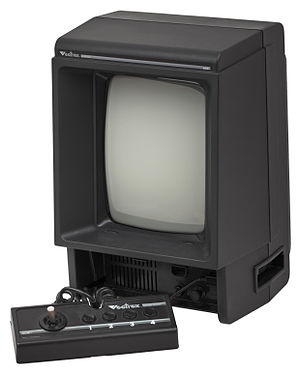Vectrex
 |
|
| Manufacturer | General Consumer Electronics (1982-83) Milton Bradley Company (1983-84) |
|---|---|
| Type | Home video game console |
| Generation | Second generation |
| Release date | |
| Discontinued | 1984 |
| Media | ROM cartridge |
| CPU | Motorola MC68A09 @ 1.5 MHz |
| Controller input | Two |
The Vectrex is a vector display-based home video game console that was developed by Western Technologies/Smith Engineering. It was licensed and distributed first by General Consumer Electronics (GCE), and then by Milton Bradley Company after its purchase of GCE. It was released in November 1982 at a retail price of $199 ($480 adjusted for inflation); as Milton Bradley took over international marketing the price dropped to $150, then reduced again to $100 shortly before the video game crash of 1983 and finally retailed at $49 after the crash. The Vectrex exited the console market in early 1984.
Unlike other non-portable video game consoles, which connected to televisions and rendered raster graphics, the Vectrex has an integrated vector monitor which displays vector graphics. The Vectrex is monochrome and uses plastic screen overlays to simulate color and various static graphics and decorations. At the time, many of the most popular arcade games used vector displays, and through a licensing deal with Cinematronics, GCE was able to produce high-quality versions of arcade games such as Space Wars and Armor Attack.
Vectrex comes with a built-in game, Mine Storm. Two peripherals were also available for the Vectrex, a light pen and a 3D imager.
The Vectrex was also released in Japan under the name Bandai Vectrex Kousokusen. In the U.S., the model number of the Vectrex is HP-3000.
The idea for the Vectrex was conceived by John Ross of Smith Engineering in late 1980. He, Mike Purvis, Tom Sloper, and Steve Marking had gone to Electro-Mavin, a surplus warehouse in Los Angeles. They found a 1" cathode ray tube from a heads-up display and considered if a small electronic game could be made of this. A demonstration of a vector-drawing cathode ray tube display was made by connecting the deflection yoke in a standard television to the channels of a stereo amplifier fed with music program material. An axillary yoke was used to keep the raster television's horizontal fly-back high-voltage system running. The demo led to a system originally conceived as a handheld called the Mini Arcade, but as Smith Engineering shopped the idea around to developers, it evolved into a tabletop with nine-inch screen.
...
Wikipedia
